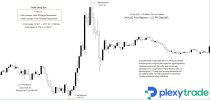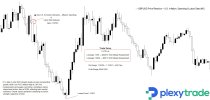️ High-Impact Economic Calendar – August 14, 2025
Timeline: GMT | Focused Currencies: AUD, GBP, EUR, USD, JPY01:30 GMT
Australia – Unemployment Rate
Forecast: 4.2% | Previous: 4.3%
Currency: AUD
Why it matters:
A lower unemployment rate could signal a job market heating up — and put the Australian dollar on the front foot. Traders will watch for any surprise drop that could stir RBA rate speculation.
01:30 GMT
Australia – Employment Change
Forecast: 13K | Previous: 2K
Currency: AUD
Trading insight:
A sharp jobs rebound here would be a bullish sign for domestic spending power and could give AUD pairs a morning boost.
01:30 GMT
Australia – Full-Time Employment Change
Forecast: 15K | Previous: -38.2K
Currency: AUD
Market pulse:
Full-time roles mean more stability and spending power. A big positive swing could hint at stronger growth ahead.
06:00 GMT
United Kingdom – GDP Growth Rate YoY
Forecast: 0.7% | Previous: 1.3%
Currency: GBP
⚠️ Market watch:
Slowing annual growth could weigh on sterling and keep BoE hawks cautious. A miss here might sour sentiment fast.
06:00 GMT
United Kingdom – GDP Growth Rate QoQ Prel
Forecast: 0.1% | Previous: 0.7%
Currency: GBP
Why traders care:
A soft quarterly number would signal fading momentum. Sterling bulls will be hoping for any upside surprise.
06:00 GMT
United Kingdom – Industrial Production MoM
Forecast: 0.3% | Previous: -0.9%
Currency: GBP
Quick take:
From contraction to growth? This could be a welcome sign that UK industry is finding its footing again.
06:00 GMT
United Kingdom – GDP MoM (June)
Forecast: 0.1% | Previous: -0.1%
Currency: GBP
Trading takeaway:
Even a small rebound matters here — it could be enough to shift short-term GBP sentiment.
09:00 GMT
Euro Area – Industrial Production MoM
Forecast: -0.6% | Previous: 1.7%
Currency: EUR
Market movers:
A pullback this sharp could stoke concerns about eurozone growth and pressure the euro.
12:30 GMT
United States – PPI MoM
Forecast: 0.2% | Previous: 0.0%
Currency: USD
Trading insight:
Higher producer prices could keep inflation chatter alive — and the Fed on edge.
12:30 GMT
United States – PPI YoY
Forecast: 2.5% | Previous: 2.3%
Currency: USD
Why it matters:
If producer prices keep climbing, markets may start bracing for stickier inflation and prolonged higher rates.
12:30 GMT
United States – Initial Jobless Claims
Forecast: 228K | Previous: 226K
Currency: USD
⚠️ Market watch:
Any uptick could hint at cooling labor momentum, while a drop could keep the USD supported.
23:50 GMT
Japan – GDP Growth Rate QoQ Prel
Forecast: 0.2% | Previous: 0.0%
Currency: JPY
Market insight:
Even modest growth here could lift yen sentiment — and make the BoJ slightly more comfortable holding policy steady.
How Markets Respond to Major Economic Announcements
U.S. PPI (MoM & YoY) – July 16, 2025
In July 2025, U.S. consumer prices rose 0.2% month-on-month and 2.7% year-on-year, as President Donald Trump’s tariffs had only a modest overall impact on inflation. Core CPI, which excludes food and energy, increased 0.3% on the month and 3.1% annually — the highest since February — driven largely by higher shelter, transportation, and medical care costs. Equity markets advanced following the release, while Treasury yields were mixed, as traders boosted expectations for a September Federal Reserve rate cut. Although tariffs influenced certain categories, such as household furnishings, their broader effect remained limited. Economists, however, warned that price pressures could persist as tariffs continue to filter through the economy.
Market Note: Geopolitical Risk & Earnings Season Volatility
Keep a close eye on geopolitical tensions — they can significantly impact market volatility, shift risk sentiment, and weigh on global equity performance.
Earnings season is a major catalyst for price action across global indices. While headline names like the US30, S&P 500, NASDAQ 100, FTSE 100, and DAX40 often take the spotlight, broader equity benchmarks worldwide can also react sharply. Market sentiment is shaped not only by results, but also by forward guidance and executive commentary — making this a key period for both opportunity and risk.
Disclaimer: The content provided is for educational and informational purposes only and is not intended as trading or financial advice. This analysis seeks to enhance your understanding of market behavior and highlight potential opportunities that may have existed, offering insights into how the market operates and the possibilities it may present.
Last edited:
















